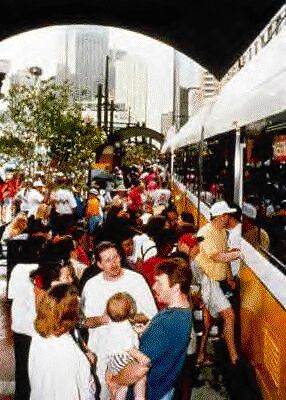
Light Rail Now/Light Rail Progress can be contacted at: Light Rail Now! |
One of the most common claims wielded by rail transit opponents (particularly in transit vote campaigns) is that urban transit travel is so minuscule as to be irrelevant and therefore a waste of public investment – encapsulated in the slogan "Costs too much, does too little". in the following examination, we look at how well this myth holds up in the light of reality. Myth: investment in major transit improvement projects, like light rail, is a waste of money, because transit carries such a tiny share of total regional travel. Total transit trips in most urban areas, even with rail and extensive bus service, are typically less than 2% of the regional total, and total passenger miles traveled on public transit are about 1% of the total, or less. Reality: These figures are virtually meaningless, and irrelevant to the real problems and characteristics of personal mobility within today's urban areas ... but Road Warriors love to brandish them before a gullible public. First, the percentages commonly apply to a metropolitan region of which only a portion (often relatively small) is typically even in the transit agency's service area. So transit is being disparaged for not carrying trips in places it doesn't even serve! Second, many of these trips (about 15%) are made by freight haulers, delivery trucks, etc. – with the driver counted as a "passenger" – and (especially on freeways) another segment (aboute 5-10%) consists of intercity trips. Both these types of trips are obviously not even in the "market" of trips transit can compete for! (But the Road Warriors don't bother to make you aware of that.)
As a consequence, lacking a grid of accessible public transit, most urban residents – and suburbanites especially – find themselves hopelessly dependent on automobiles for mobility. Many parents are forced to transport their kids to school – generating more passenger trips (including the driver). Even within many of today's inner-cities, residents must hop in their car for a trip to buy simple necessities and other common items like salt, milk, or a newspaper. You must use your car to buy gas, go to the carwash, or get an oil change. You must shuttle from sprawling mall to mall, from Big Box store to store, to buy necessities for human life. All these mean more and more trips – and all of them are tallied up on the regional trip counter. (And keep in mind that even the trips to a transit park & ride are counted as automobile trips and passenger-miles!) Meanwhile, as the automobile system is racking up all those trips, activities based on transit, in contrast, are far more compact and efficient. in cities with good rail transit, passengers have the opportunity to buy some things at shops and malls near their transit stops. Many rail transit passengers benefit from convenient multi-use inner-city or downtown malls which some developers have seen desirable to build at rail stations. (in Dallas, this is already starting to happen at major stations such as Cityplace and Mockingbird.) Multiple trips to far-flung locations gradually become unnecessary – thus, most passengers need only two trips on transit – one to get to the original destination, and one to get back. And their passenger-mileage is much less as well. But, beause of this efficiency, transit users fall far behind in the total numbers of "trips" tallied and passenger-miles logged. What this means is that the very inefficiencies and wastefulness of the automobile system are exploited by Road Warriors as they try to build a case for the automobile and disparage mass transit!
That's where most of the congestion really is. Those mobility needs are also the hardest and most expensive to serve by any mode – and especially expensive to serve by motor vehicle facilities. To build just one single mile of a single lane of Boston's "Big Dig" inner-city roadway tunnel, for example, is costing about $1 billion! (See our article So Rail Transit's a Boondoggle? No, it's a CAR TUNNEL.) But rail transit excels in serving inner cities – that's why it seems so much more "expensive" when local Road Warriors compare it to the cost of (largely suburban and rural) freeways. And it's rail transit that seems to have the greatest capability of getting cars out of traffic and out of competition for scarce (and increasingly expensive) parking facilities. Those benefits get "disappeared" by the rail critics when they brandish their "2% of regional travel" red herring. Updated 2003/10/04 |
|
|
|